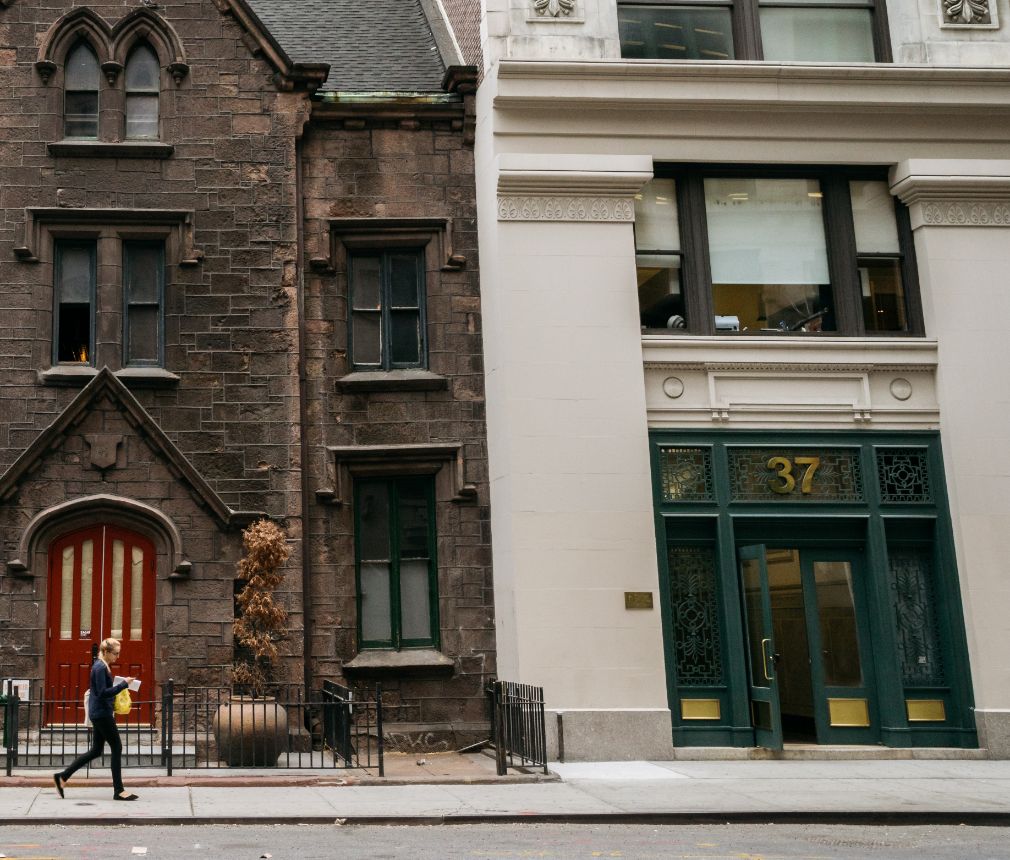Hammertoe Surgery
in New York City
Hammertoe Surgery
Our feet serve us faithfully for years, but we tend to notice them only when something goes wrong. Sometimes, these conditions worsen to the point of requiring a procedure to correct the issue. Hammertoe surgery is designed to correct a second, third, fourth, or fifth toe defect. There are multiple types of hammertoe deformities, sometimes termed “mallet toe” and “claw toe,” depending on which toe joints are involved.
This surgery is typically performed to alleviate pain and improve the flexibility of the toe(s), allowing them to straighten and function optimally.
Surgery is the only option for rigid hammertoe when the toe can not be manually straightened; however, in some cases, the toe can still be manipulated, known as flexible hammertoe, and manual therapy can help this condition.
Hammertoe

What Causes Hammertoe?
Hammertoe is a toe deformity caused by an imbalance in the muscles, tendons, and ligaments that usually keep the toe straight when relaxed. The following circumstances can lead to this condition:
- Many hammertoe cases stem from wearing high heels or tight shoes. This can cause too much pressure on your toes; over time, the toe muscles weaken and cease functioning correctly.
- Rheumatoid arthritis and other similar medical conditions can contribute to hammertoe development by causing progressive deterioration in the joints of the feet.
- Chronic nerve damage resulting from diabetes and a muscle imbalance due to stroke or spinal cord injury can also decrease normal function in feet, resulting in hammertoe.
Chelsea Foot and Ankle in New York City provides effective surgical options to treat rigid hammertoe. We also offer non-surgical treatment for flexible hammertoe to restore function and alleviate pain.
How Do I Know if I Have Hammertoe?
The telltale signs of hammertoe include the following:
One or more toes bend upward at the toe’s first “knuckle” joint, also known as the PIP joint.
Blisters or calluses have formed in the spot(s) where your toe(s) rub against your shoes.
Pain at the base of the toe joint.
Why Choose Chelsea Foot and Ankle
To Treat Your Hammertoe?
Our team members respect our patients as well as their time and work hard to create and execute customized treatment plans that meet their unique needs. We understand how everyone depends on their feet and how debilitating it is not to be able to walk without pain and discomfort.
When you choose Chelsea Foot and Ankle as your provider, you can expect to be treated like family and the VIP you are. Because of our commitment to you, we offer comprehensive podiatry care at reasonable prices with friendly staff ready to help with any questions or billing issues.
What Are Your Non-Surgical Hammertoe Treatment Options?
For flexible hammertoe, there are several approaches the doctor may take while making specific recommendations for you to follow.
In-office treatments:
- Manually mobilizing the toe(s)
- Splinting or taping the toe(s) in the correct position with padding to cushion them
- Custom orthotics with forefoot modifications that can help slow the progression of the hammertoe deformities
Likely recommendations of at-home therapies we will instruct you to practice:
- Stretching your toes properly
- Using ice to decrease pain and swelling while reducing inflammation
- Wearing looser, comfortable shoes at least one half-inch longer than your longest toe
- Practicing foot, toe, and calf stretches to regain their normal mobility and function
- Performing strengthening exercises, like using your toes to pick up items from the floor
What if You Need Hammertoe Surgery?
Choosing the proper method for hammertoe correction is crucial in achieving the most successful outcome. You want to be sure that your feet are restored to full function and that all the defects have been addressed.
At Chelsea Foot and Ankle in Manhattan, we use a combination of diagnostic tools, including obtaining an in-depth medical history, performing a thorough examination, and ordering the appropriate imaging techniques to get a clear picture of your condition.
This attention to the minor details of your case will determine the surgical procedure(s) we will use to treat your hammertoe.
Some of these procedures include:
- Joint resection (Arthroplasty) – With this surgery, our surgeon will cut the constricted ligaments and tendons to release the joint. A small portion of bone needs to be removed in order to straighten the joint, and you may require a temporary pin to be put in place to prevent the toe from moving. Pins are typically removed a few weeks following the procedure.
- Fusion (Arthrodesis) – Fusion surgery is another solution to straighten the toe and relieve pain. The surgeon will perform a joint resection and remove the ends of the bones to prepare them to grow together, known as a fuse. Pins are one way to help the joint remain stable after surgery, and they are removed when the joint has completed the fusion process. Our surgeons often prefer to use joint implants to fuse toe joints. This leads to better long-term success and, in our experience, allows our patients to get back into closed shoes and sneakers sooner and resume normal activities faster.
Ultimately, after being fully informed by our surgeon, it is up to you to decide on any surgical treatment option. We respect your autonomy and support your decisions, even if you choose to obtain a second opinion.
What Is Recovery From Hammertoe Surgery Like?
After your surgery, patients can expect some persistent swelling, which will lessen over time. This typically lasts for a minimum of four to six weeks. However, everyone is different, and healing times can vary. Swelling can last from months up to a year in some rare cases.
You must wear a special shoe to protect and support your toe(s) following the procedure. Most people wear this post-op shoe for around four to six weeks. At that point, the swelling is usually reduced enough that people can resume wearing regular shoes or sneakers, provided they are roomy and not too narrow.
Our procedures are designed so patients can bear weight immediately after hammertoe surgery and walk, albeit in a post-op surgical shoe. Whenever possible, we ask that our patients keep their treated foot elevated to reduce their swelling and shorten the healing time.
Patients may need a cane for a few weeks to make walking less difficult.
Your surgeon will remove any pins and stitches a few weeks after your procedure.
You will be sent for physical therapy a few weeks after surgery and given new instructions on the post-operative exercises needed to strengthen the toes and other muscles in the foot. Continuing these exercises after you heal can help prevent hammertoe from returning.
It is also essential to wear comfortable, well-fitting shoes and to follow your surgeon’s directions to protect the joint.
How Can You Prevent Hammertoe?
Properly fitting footwear is the best way to prevent hammertoes. If you have rheumatoid arthritis, nerve damage, or a history of hammertoe, the following tips can help you reduce your risks.
- Avoid high heels
- Wear shoes that are comfortable and fit properly
- Exercise your feet
- Practice occasionally picking up small objects with your toes to keep them flexible
Your New York City Podiatrist for Hammertoe Treatment
Whether you have flexible hammertoe and require only conservative treatment or if you have rigid hammertoe that needs surgery, you can trust the doctors at Chelsea Foot and Ankle to diagnose and recommend the best course of action for restoring your feet to full functionality.
We also treat the following conditions:

Hammertoe FAQ
How can I prepare for hammertoe surgery?
The nature of each procedure and treatment plan will be individualized for the patient; however, here are some general tips to prepare for hammertoe surgery:
- Maintain good hygiene of your affected foot—trim and keep your toenails clean, remove all nail polish, and avoid shaving the area yourself before surgery. You may be prescribed a particular soap that reduces the amount of bacteria on your foot; use this as directed.
- Adjust medications prior to surgery at the advice of your physician. Certain blood thinners can be dangerous if taken close to a surgical procedure.
- Be sure to inform your surgeon about all medications, vitamins, and supplements before your procedure.
- Stop smoking before surgery – nicotine products restrict blood vessels, reducing blood flow.
- Discuss any questions and concerns with your surgeon, and always follow their instructions.
What happens on the day of surgery?
The morning of the surgery may look like this:
You will receive specific instructions for your procedure before surgery. In some cases, you may be instructed to fast for a few hours prior to surgery. You will also need to plan to have someone drive you home following the procedure, as you may be recovering from anesthesia. It’s also a good idea to wear loose-fitting clothing, as you may have a large bandage on your foot when you are released.
Once at the surgical center, the treatment area may be marked with a pen for accuracy. You will be administered a type of anesthesia so that you will be comfortable throughout the procedure; you may have the area completely numbed, known as local anesthesia, or you may sleep through the process under general anesthesia. The procedure itself can take anywhere from 30 to 60 minutes to complete.
Once the procedure is over, your surgical site will be bandaged or otherwise protected. You will be monitored as you recover from anesthesia and cleared to go home with the assistance of your chosen responsible adult driver. You may need to schedule a post-operative check-up at this time, be prescribed pain medications or antibiotics, and then be sent home with post-operative instructions.
How can I make hammertoe surgery recovery easier?
The best way to improve your recovery period is to follow your post-surgical instructions strictly. Wear your post-op shoe for the entire length your surgeon requires—no cheating by taking days off. As you recover, do not push yourself. Whenever you feel tired, rest your foot. Be sure to elevate it as much as possible. The better you care for your foot during recovery, the better you will heal.
For all surgical recovery periods, it’s also a good idea to practice a healthy lifestyle by eating healthy and moving your body. Ensuring your body receives enough vitamins and nutrients is crucial to the healing process, as is keeping your blood flow normal. Within the instructions of your aftercare process, try to walk around a little every day, even in early recovery. This will increase your circulation and allow your body to heal faster.
Recovery can sometimes be frustrating, but even when you start to feel better, be sure not to push yourself too much. Always call your surgeon if you have any questions or are unsure if you are cleared for a new activity.
Are you interested In healing your Hammer Toe?
If you are suffering from pain due to hammertoe in New York City or any foot and ankle problem, call our office today at (646) 929-4149! Don’t forget to check out our blog to learn more about us!
We always put our best foot forward…so you can too!
Our Patients Love Us
An absolutely amazing experience. Dr. Ciment is an absolutely wonderful person – it is very evident that he truly cares about his patients.
What a pleasure to meet Dr. Shastri. She was extremely personable, listened intently and actually was able to treat my condition to a fair extent in the first sitting.
Highly recommend her.
